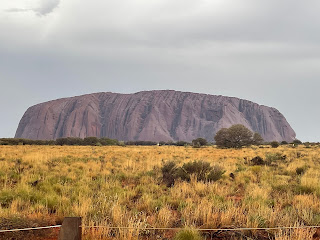The van was packed and we were off down the highway this morning from Alice Springs, heading toward the town of Yulara, near the location of Uluru rock.
There were miles and miles of nothing but miles and miles. We drove an hour before coming to the first rest stop -- the only gas station or other sign of civilization in 100 kilometers.
Three hours later, the scenery was unchanged. There were, what we would call truck stops, every 60 or 70 miles, but there was nothing in between them -- no towns, no settlements, no nothing.
We did see smoke on the horizon a couple times. Fires start here from lightning, careless humans, or a certain bird of prey that uses fire to smoke out small desert mice for easy hunting. The birds will find a fire in progress, pick up a hot coal in their talons, and drop it in another place to start a fire there and wait for the mice to flee.
One truck stop had a fenced-in area with a bunch of emus. That broke the monotony only a little. It's hard to imagine living and working in one of these places. They all have trailers out back where the proprietors and employees live, in the midst of nothingness for miles around.
Late in the morning, the skies clouded over and turned dark. We saw some brilliant displays of cloud-to-ground lightning, which was a good illustration of how brush fires start. These storms often come through dry, or with very little rain. Our tour leader and driver were both quite surprised when it began to rain fairly heavily, at least off and on.
Lunch was supposedly at a "cattle station" (what we would call a ranch). But it appeared to be just another truck stop with smellier restrooms. Lunch was cold sandwiches on white bread, with hot water for making tea or instant coffee. There was a "shop," but it sold very little other than beer, wine, and soft drinks at highly inflated prices.
The van stopped at a turn-off, and although the clouds and rain obscured it somewhat, we could see in the distance a large, flat monolithic rock called Mt. Conner, or in the native language, Artilla. Some people also have dubbed it "Fooluru," because some misinformed tourists see it and think they are seeing Uluru. Some even take their photos here and turn around, thinking that they've already seen the great rock.
Across the road from this turn-off was a sand dune. At the top of the dune we had a nice, panoramic view of a large salt flat. In the sun, it looks white. In clouds and rain, it was more grey.
As we approach Yulara, the rains became a torrent. Our tour leader described it as "a once in a lifetime" event. The van had to slow down for water pooled on the roadway. We checked into our hotel, which had outdoor hallways. We got soaked finding our rooms, and the walkways were mostly under water.
The rain abated a bit by 4 p.m. and we met at the van to go visit Uluru. The immense size of this rock is difficult to grasp until one actually sees it. It rises more than 1000 feet above the surrounding landscape and is almost six miles in diameter. In addition to what is visible above ground, it extends several miles down into the earth.
Our local driver/guide took us to one of many shallow "caves," which are really just indentations into the rock, most not more than 10-15 feet deep, and fairly wide. He showed us paintings on the walls, some of which date back 5,000 years.
The rain resumed, and there were puddles of reddish water everywhere. It was had to walk on the designated paths without getting one's feet soaked.
A watering hole, that the guide said held only a tiny puddle of water three days ago, was bank full, with streams of water coming down the rock on all sides.
The aboriginal native people regard this rock as sacred, and there are mythical stories attached to almost every crack, hole, or feature of the rock. Many of these stories carry morals for children and other members of the clans, but other stories are so sacred that they can only be told among the elders. There are some rock features regarded as too sacred to be photographed, and signs are posted in those areas.
After visiting several cave sites, we drove to the "sunset viewing area." Our tour leader and our guide marveled at how few vehicles were in the parking lot. Many of the big motor coaches decided not to come out because of the rain. However, nearly every bus or van -- including ours -- had a table with spread with charcuterie and bottles of champagne.
When the sun was under cloud, the rock appeared a dull grey. But the sun broke through the clouds just before setting, and the changing color of the stone was amazing. The effect was even more profound with the glitter of light on the streams of water still flowing down the sides. Our guide told us that he had only seen such a site once before, out of hundreds of sunsets here.
Returning to the hotel, we washed out our soaked clothing and got ready for an early start tomorrow.














No comments:
Post a Comment